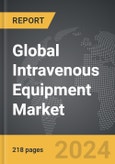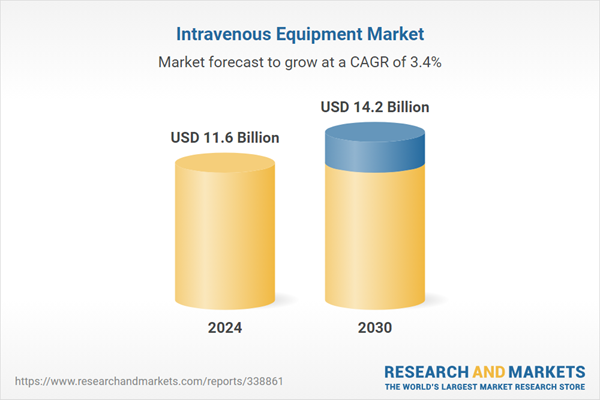Global Intravenous Equipment Market - Key Trends and Drivers Summarized
Intravenous (IV) equipment is essential for administering fluids and medications directly into the bloodstream. This equipment typically includes tubing that connects a fluid-filled bag to a patient's vein, usually located in the hand or arm. The flow of fluids and medicines is commonly facilitated by gravity, which allows the contents of the bag to be delivered steadily and reliably into the bloodstream. This method is critical for treatments that require rapid and efficient delivery of therapeutic substances. The infusion therapy market is expanding rapidly due to the growing prevalence of chronic illnesses such as cancer and diabetes, along with an aging population requiring continuous treatment. Market leaders such as Baxter, Fresenius, B. Braun, and Terumo dominate the sector, but smaller competitors are making strides with innovative technology and delivery systems.One of the most significant trends propelling market growth is the transition of infusion therapy to alternative care settings such as specialty clinics, ambulatory surgery centers (ASCs), and home care. Specialty clinics offer personalized, condition-specific treatment with shorter wait times and flexible scheduling. ASCs provide complex care without the higher costs of hospitals, while home care enables patients to receive treatment in a familiar, comfortable setting. Portable and wearable infusion pumps are a major technological development, offering precise medication delivery with patient mobility. Meanwhile, antimicrobial-coated IV sets, needleless connectors, and stopcocks ensure improved safety and efficiency. Several trends are shaping the IV filter market and contributing to its growth. One of the most important is the development of specialized membranes in IV filters, including 0.2-μ m pore membranes for bacteria and 1.2-μ m mesh membranes for lipids. These tailored membranes enable precise removal of particles such as bacteria, air bubbles, and lipid clusters from intravenous solutions.
Despite promising market potential, challenges such as a shortage of trained healthcare professionals and high equipment development costs remain. In rural areas, limited access to trained professionals exacerbates this shortage. High R&D and production costs also lead to increased prices, restricting access for some patients and straining healthcare budgets. Close collaboration between medical device companies, healthcare providers, and insurers is essential to create innovative and affordable equipment. Overall, the infusion therapy market has a bright future, with significant potential to enhance patient outcomes and quality of life through continuous advancements.
Report Scope
The report analyzes the Intravenous Equipment market, presented in terms of market value. The analysis covers the key segments and geographic regions outlined below.- Segments: Product Type (IV Catheters, Securement Devices, Administration Sets, Infusion Sets, Drip Chambers, Other Product Types); End-Use (Hospitals & Clinics, Ambulatory Care Centers, Other End-Uses).
- Geographic Regions/Countries: World; United States; Canada; Japan; China; Europe (France; Germany; Italy; United Kingdom; Spain; Russia; and Rest of Europe); Asia-Pacific (Australia; India; South Korea; and Rest of Asia-Pacific); Latin America (Argentina; Brazil; Mexico; and Rest of Latin America); Middle East (Iran; Israel; Saudi Arabia; United Arab Emirates; and Rest of Middle East); and Africa.
Key Insights:
- Market Growth: Understand the significant growth trajectory of the IV Catheters segment, which is expected to reach US$4.8 Billion by 2030 with a CAGR of a 3.9%. The Securement Devices segment is also set to grow at 4.2% CAGR over the analysis period.
- Regional Analysis: Gain insights into the U.S. market, valued at $3.1 Billion in 2024, and China, forecasted to grow at an impressive 6% CAGR to reach $2.9 Billion by 2030. Discover growth trends in other key regions, including Japan, Canada, Germany, and the Asia-Pacific.
Why You Should Buy This Report:
- Detailed Market Analysis: Access a thorough analysis of the Global Intravenous Equipment Market, covering all major geographic regions and market segments.
- Competitive Insights: Get an overview of the competitive landscape, including the market presence of major players across different geographies.
- Future Trends and Drivers: Understand the key trends and drivers shaping the future of the Global Intravenous Equipment Market.
- Actionable Insights: Benefit from actionable insights that can help you identify new revenue opportunities and make strategic business decisions.
Key Questions Answered:
- How is the Global Intravenous Equipment Market expected to evolve by 2030?
- What are the main drivers and restraints affecting the market?
- Which market segments will grow the most over the forecast period?
- How will market shares for different regions and segments change by 2030?
- Who are the leading players in the market, and what are their prospects?
Report Features:
- Comprehensive Market Data: Independent analysis of annual sales and market forecasts in US$ Million from 2024 to 2030.
- In-Depth Regional Analysis: Detailed insights into key markets, including the U.S., China, Japan, Canada, Europe, Asia-Pacific, Latin America, Middle East, and Africa.
- Company Profiles: Coverage of players such as Aytu BioScience Inc., Bayer Healthcare Pharmaceuticals, Bracco Diagnostics Inc., Curium, Daiichi Sankyo Company Limited and more.
- Complimentary Updates: Receive free report updates for one year to keep you informed of the latest market developments.
Some of the 91 companies featured in this Intravenous Equipment market report include:
- AngioDynamics Inc.
- Arcomed AG
- ASCOR S.A.
- B. Braun Melsungen AG
- Baxter International Inc.
- Becton, Dickinson and Company
- F. Hoffmann-La Roche Ltd.
- Fresenius SE & Co. KGaA
- Halyard Health Inc.
- ICU Medical Inc.
- Insulet Corp.
- Medtronic PLC
- Moog Inc.
- Nipro Corporation
- Smiths Medical
- Tandem Diabetes Care Inc.
- Teleflex Inc.
- Terumo Corp.
This edition integrates the latest global trade and economic shifts into comprehensive market analysis. Key updates include:
- Tariff and Trade Impact: Insights into global tariff negotiations across 180+ countries, with analysis of supply chain turbulence, sourcing disruptions, and geographic realignment. Special focus on 2025 as a pivotal year for trade tensions, including updated perspectives on the Trump-era tariffs.
- Adjusted Forecasts and Analytics: Revised global and regional market forecasts through 2030, incorporating tariff effects, economic uncertainty, and structural changes in globalization. Includes historical analysis from 2015 to 2023.
- Strategic Market Dynamics: Evaluation of revised market prospects, regional outlooks, and key economic indicators such as population and urbanization trends.
- Innovation & Technology Trends: Latest developments in product and process innovation, emerging technologies, and key industry drivers shaping the competitive landscape.
- Competitive Intelligence: Updated global market share estimates for 2025, competitive positioning of major players (Strong/Active/Niche/Trivial), and refined focus on leading global brands and core players.
- Expert Insight & Commentary: Strategic analysis from economists, trade experts, and domain specialists to contextualize market shifts and identify emerging opportunities.
Table of Contents
Companies Mentioned (Partial List)
A selection of companies mentioned in this report includes, but is not limited to:
- AngioDynamics Inc.
- Arcomed AG
- ASCOR S.A.
- B. Braun Melsungen AG
- Baxter International Inc.
- Becton, Dickinson and Company
- F. Hoffmann-La Roche Ltd.
- Fresenius SE & Co. KGaA
- Halyard Health Inc.
- ICU Medical Inc.
- Insulet Corp.
- Medtronic PLC
- Moog Inc.
- Nipro Corporation
- Smiths Medical
- Tandem Diabetes Care Inc.
- Teleflex Inc.
- Terumo Corp.
Table Information
| Report Attribute | Details |
|---|---|
| No. of Pages | 337 |
| Published | December 2025 |
| Forecast Period | 2024 - 2030 |
| Estimated Market Value ( USD | $ 11.6 Billion |
| Forecasted Market Value ( USD | $ 14.2 Billion |
| Compound Annual Growth Rate | 3.4% |
| Regions Covered | Global |









